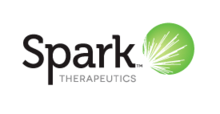Spark Therapeutics
 | |
| Traded as |
NASDAQ: ONCE Russell 2000 Component |
|---|---|
| Industry | Biotechnology, Pharmaceutical |
| Founded | 2013 in Philadelphia, Pennsylvania, United States of America |
| Founders | Jeffrey Marrazzo, Katherine High |
| Headquarters | Philadelphia, United States of America |
| Website |
sparktx |
Spark Therapeutics is a startup pharmaceutical company that develops gene therapies.[1][2][3] It was founded in 2013 by Katherine High and Jeffrey Marrazzo in and effort to commercially develop treatments against haemophilia that High was working on at Children's Hospital of Philadelphia.[4]
Products and pipeline
Voretigene neparvovec
Voretigene neparvovec, marketed under the tradename Luxturna, is a gene therapy approved by the Food and Drug Administration for treatment of Leber's congenital amaurosis, a rare genetic eye disease.[5]
Fidanacogene elaparvovec
Fidanacogene elaparvovec, previously known by its study ID number SPK-9001,[6] is an experimental drug under investigation for treatment of hemophilia B. Spark partnered with pharmaceutical giant Pfizer to develop fidanacogene elaparvovec.[2] Fidanacogene elaparvovec is an adeno-associated viral vector which is designed to transfer a working copy of the Factor IX gene into the livers of patients who carry non-functioning copies.[7] In July, 2018 Pfizer said fidanacogene elaparvovec was entering late stage clincal trials.[8]
SPK-8011
SPK-8011 is an experimental drug under investigation for treatment of hemophilia A. It is entering phase III clinical trials in the United States. The therapy transfers a working copy of the Factor VIII gene into patients who lack one. In Phase II clinical trials 2 of 7 patients receiving the highest dose of the drug suffered immune responses. One patient had to be hospitalized. The reactions against the treatment were seen as a set back, though Spark suggested the responses could be controlled with steroids and promised to move forward with Phase III testing.[9][10]
References
- ↑ "Spark Therapeutics reports 3Q loss". Associated Press. 7 November 2017. Retrieved 16 November 2017.
- 1 2 George, John (7 November 2017). "Spark, Pfizer amend agreement for experimental hemophilia gene therapy". Philadelphia Business Journal. Retrieved 16 November 2017.
- ↑ Marchione, Marilynn (10 October 2017). "A gene therapy that could cure blindness is on the brink of getting approved". Business Insider. Retrieved 16 November 2017.
- ↑ Crow, David (19 October 2017). "Gene therapy helped these children see. Can it transform medicine?". Financial Times. Retrieved 16 November 2017.
- ↑ "FDA approves novel gene therapy to treat patients with a rare form of inherited vision loss". FDA. 19 Dec 2017. Retrieved 20 Dec 2017.
- ↑ "Pfizer Initiates Pivotal Phase 3 Program for Investigational Hemophilia B Gene Therapy" (Press release). Pfizer. 16 July 2018. Retrieved 2018-07-18.
- ↑ Lindsey, George (1 December 2016). "Spk-9001: Adeno-Associated Virus Mediated Gene Transfer for Hemophilia B Achieves Sustained Mean Factor IX Activity Levels of >30% without Immunosuppression". Blood. 128 (22): 3. Retrieved 16 November 2017.
- ↑ George, John (16 July 2018). "Pfizer begins late-stage testing of Spark's hemophilia B gene therapy". Philadelphia Business Journal. Retrieved 18 July 2018.
- ↑ Garde, Damian (7 August 2018). "Spark's gene therapy data answer some burning questions — and raise a few more". Stat. Retrieved 7 August 2018.
- ↑ Tirrell, Meg (7 August 2018). "Spark Therapeutics shares lose a third of their value as hemophilia gene therapy trial disappoints investors". CNBC. Retrieved 7 August 2018.